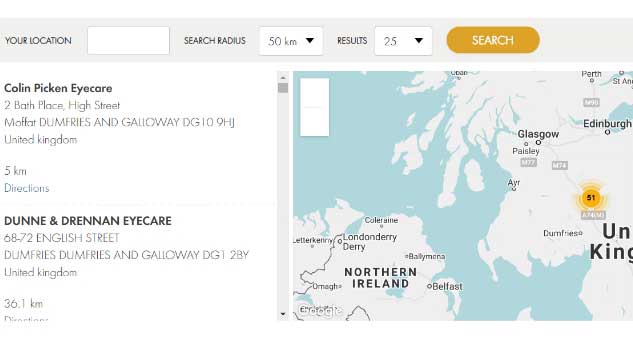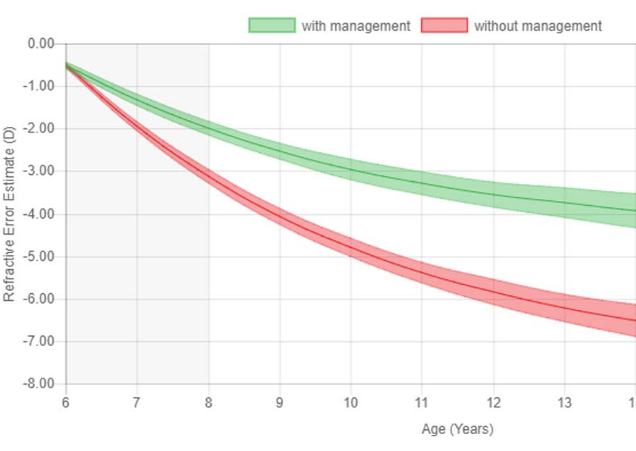MYLO
SOFT CONTACT LENSES
FOR MYOPIA MANAGEMENT
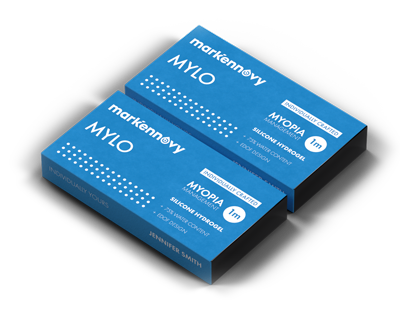
- Proven technology to slow myopia progression.
- Individually crafted to the specifications of your eye and prescription.
- Silicone Hydrogel material for excellent oxygen flow to the eye.
A CLOSER LOOK AT YOUR MYOPIA
WHAT IS MYOPIA?
Myopia is commonly known as nearsightedness. This condition results in blurred vision mainly at far distance. To compensate for this refractive error, divergent lenses are used so that light rays form the image on the retina and not in front of the retina.
Myopia can be axial (the eye is longer than normal) or refractive (the eye is overly powerful) and therefore light comes to focus in front of the retina in absence of accommodation.
DID YOU KNOW THAT MYOPIC EYES ARE LONGER?
At birth, the human eye usually measures around 17mm from front to back, a measurement referred to as axial length. During our first year of life, eye growth is most accelerated, reaching an axial length of 21mm1. The growth of a non-myopic eye then typically slows down until adolescence when the axial length stabilises at around 23 to 24mm. The axial length of a myopic eye on the other hand continues growing disproportionately, becoming elongated. This causes blurred distance vision as light comes to focus in front of the retina.
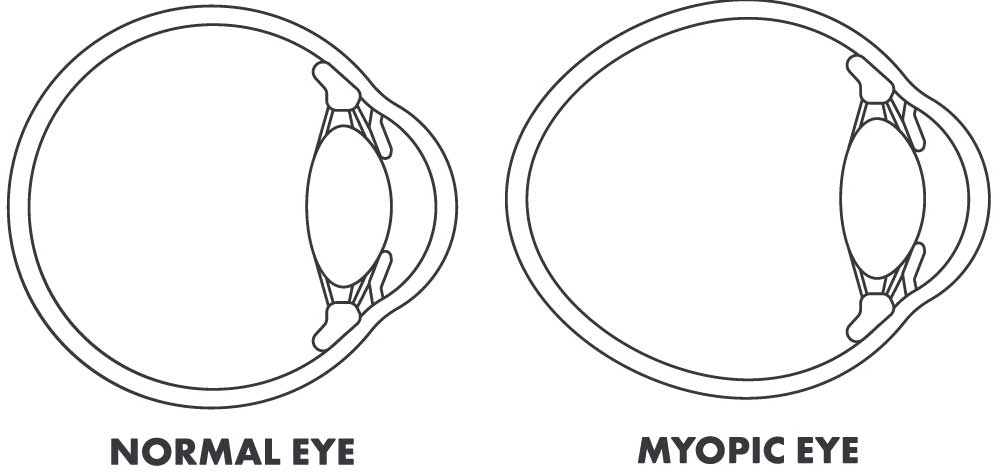
WHY IS EARLY INTERVENTION SO IMPORTANT?
The elongation of a myopic eye not only compromises our vision, but also the integrity of our eye’s structures. This can increase the likelihood of blinding ocular complications, irrespective of the level of myopia.2-5
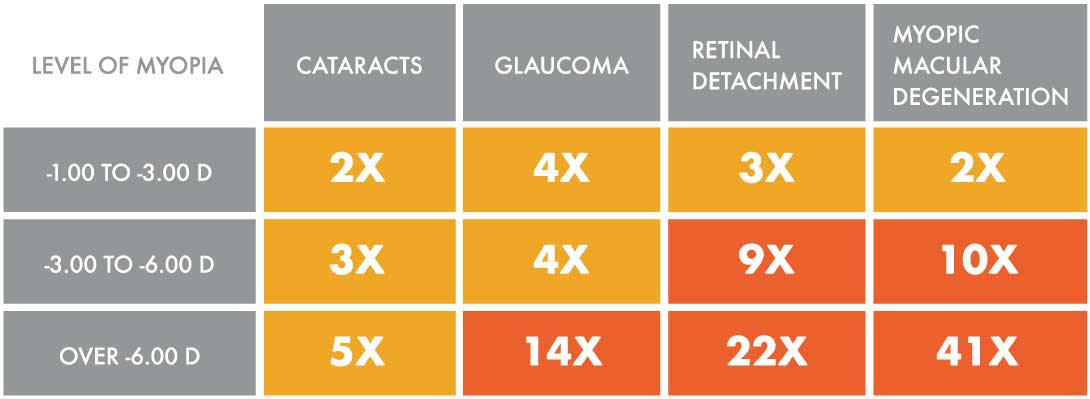 Increase in risk of ocular complications over one's lifetime
Increase in risk of ocular complications over one's lifetime
WHAT ARE THE RISK FACTORS6 FOR MYOPIA?
There are a handful of elemental factors that put us at risk for high myopia.

Refractive Error
+0.75 or less at age 6-7 years indicates higher risk in the future

Age
Children under age 9 have a faster progression

Ethnicity/
Geography
Individuals of East Asian descent are at higher risk

Parental myopia
One or both parents are myopic
LIFESTYLE FACTORS ARE ALSO FUELLING THE MYOPIA BOOM6
Two important lifestyle trends are currently accelerating myopia progression.

More near work
More than 2.5 hours per day

Less outdoor time
Less than 1.5 hours per day
ONE OUT OF TWO PEOPLE WILL BE MYOPIC BY 20507
On a global scale, myopia currently affects around 33% of the population. Although this is already a concerning rate, future myopia prevalence is even more alarming, with 50% of the global population projected to be myopic by 2050. Myopia prevalence in Europe is expected to follow the global trend, reclassifying myopia from refractive error to pandemic.
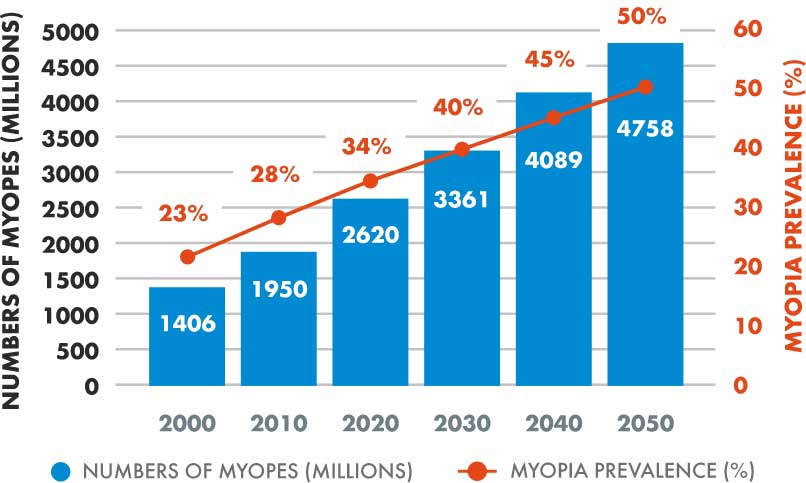 Evolution of global myopia prevalence over time
Evolution of global myopia prevalence over time
FREQUENTLY ASKED QUESTIONS
How old should my child/teenager be to start wearing myopia management soft contact lenses?

When the user can insert and remove the contact lenses on his own, the patient is ready. At 6 years old, for example, we will need collaboration and commitment from the parents. It is suggested to start when myopia progression exceeds -0.50 dioptres in the last year.
How old should my child/teenager stop the myopia management treatment?

There is not a specific, established age to stop the treatment. It will depend on the myopia progression of each child/teenager. The eye care practitioner should assess the evolution of myopia in every case and decide (according to the level of myopia and the possible risks) if it is necessary to stop the myopia management treatment.
How safe is the myopia management treatment?

The use of myopia management contact lenses is very safe when managed properly by children and by parents. Proper lens care and handling must be performed to maintain eye health and reduce the risk of eye infections. In addition, no increased risk of complications associated with soft contact lens in children exist compared to adult wearers. Before the eye care practitioners prescribe them, they will teach your children and you to manage all aspects of lens wear for your children to accomplish an independent wear.
Simple lifestyle changes can help keep myopia low!
The following practices can impede the onset of myopia:
 Spending at least 90 minutes per day outdoors.
Spending at least 90 minutes per day outdoors.
 Taking regular breaks from near work.
Taking regular breaks from near work.
 Limiting near tasks after school to 2 hours per day.
Limiting near tasks after school to 2 hours per day.
 Increasing exposure to natural lighting.
Increasing exposure to natural lighting.
 Follow the “20-20-20” Rule: every 20 minutes, shift your eyes to look at an object at least 20 feet away, for at least 20 seconds.
Follow the “20-20-20” Rule: every 20 minutes, shift your eyes to look at an object at least 20 feet away, for at least 20 seconds.
CUSTOMISE THE BOX WITH YOUR PATIENT'S NAME
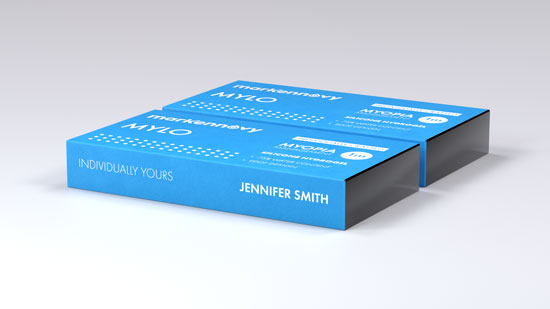
Individually Yours is a carefully selected suite of features, which help your eye care professional add a personal touch to your individually crafted contact lenses. One of the primary features of Individually Yours is the option to engrave your name on each and every one of your boxes.
We also engrave for which eye, left or right, is every box to make lens identification and handling easier. After all, your lens wearing experience should not be interrupted by discerning which lens is for which eye.
MYLO: A NEW MYOPIA MANAGEMENT SOFT CONTACT LENS
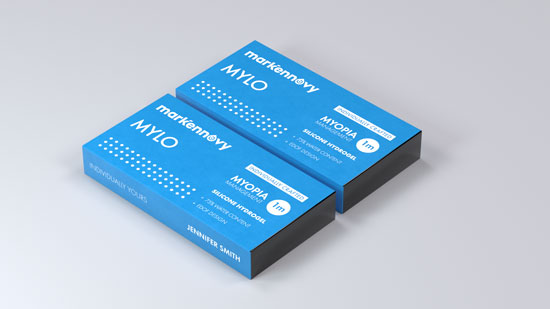
MYLO contact lenses are powered by the Brien Holden Vision Institute’s patented Extended Depth of Focus technology, which has been proven effective in reducing myopia progression and, therefore, the inherent risks associated with higher levels of myopia. Individually crafted from our innovative silicone hydrogel material, MYLO provides an excellent balance of comfort and oxygen transmission to the eye. Its wide range of parameters supports a more precise contact lens fit, allowing MYLO to be carefully calibrated to your eye at any age or stage of myopia management. Ask your Eye Care Professional how MYLO could be a perfect fit for managing myopia.

INSERTING YOUR CONTACT LENSES

1. Wash your hands
Wash your hands with a neutral soap, and then rinse and dry them thoroughly.

2. Take out your lenses
Pull off the blister foil or open the lens case and spill the content on the palm of your hand. If necessary, slide the lens out of the blister or case using your fingertip.

3. Rinse your lenses
Rinse the lens with the multipurpose or saline solution recommended by your eye care practitioner.

4. Observe your lenses
Make sure the contact lenses are clean and observe whether the edge of the lens is correct (Fig. 1) or incorrect. (Fig. 2).

5. Place your lenses
Place the lens on the index finger of your hand. With your other hand, pull up the upper eyelid just under the eyelashes. With your middle finger (of the hand holding the contact lens), pull down the lower eyelid, look up and place the lens gently on the lower white part of your eye. The lens will position itself.

6. Check your lenses
Look down, slowly release your eyelid and blink. To help the lens centre itself, close your eye and gently rub your eyelid in a circular motion.
REMOVING YOUR CONTACT LENSES

1. Wash your hands
Wash your hands with a neutral soap, and then rinse and dry them thoroughly

2. Make sure lens is centered
Make sure the lens is centred on the cornea. This can be done by looking in the mirror. If your vision is clear, the lens is centred correctly.

3. Slide the lens downwards
Pull down the lower eyelid with your middle finger, look upwards and place your index finger on the lens. Slide the lens downwards without raising the index finger and softly pinch the lens using your finger and thumb.

4. Remove your lenses
Always use your fingertips, never your fingernails. If the lens cannot be removed, blink a few times and/or apply a lubricating eye drop and then try again following the previous steps.

5. Clean and disinfect
Clean and rub the lens, then disinfect, using the recommendations of your eye care practitioner.

6. Store contact lenses
Fill your contact lens case with fresh care solution recommended by your eye care practicioner. Place your lenses into the case.
ABOUT THE BRIEN HOLDEN VISION INSTITUTE
The Brien Holden Vision Institute is a non-profit translational research, education and public health organisation. For over 30 years, the Institute has been developing superior solutions for the correction of refractive errors, with a focus on myopia. A social enterprise, the Brien Holden Vision Institute invests its revenues into delivering accessible eye care and education programs around the world, working to eliminate vision impairment and avoidable blindness.

- Hussain, RN et al, 2014. Axial length in apparently normal pediatric eyes. European Journal of Ophthalmology, 24/1, 120-3
- Chen, S.-J. et al. Prevalence and associated risk factors of age-related macular degeneration in an elderly Chinese population in Taiwan: the Shihpai Eye Study. Invest. Ophthalmol. April 2008.
- Li, T., Du, L. & Du, L. Prevalence and Causes of Visual Impairment and Blindness in Shanxi Province, China. Ophthalmic Epidemiol. July 2015 .
- Flitcroft, D. I. The complex interactions of retinal, optical and environmental factors in myopia aetiology. Prog Retin Eye Res. November 2012.
- Qiu et al. Association between Myopia and Glaucoma in the United States Population. Investigative Ophthalmology & Visual Science. January 2013.
- Myopia Profile/Kate Gifford. 2013. Myopia Profile English Version. [ONLINE] Available at: http://www.myopiaprofile.com/download/english-version/. [Accessed 12 June 2018].
- Holden et al. Global Prevalence of Myopia and High Myopia and Temporal Trends from 2000 through 2050. Ophthalmology. May 2016.
- Contact Lens Spectrum/Michaud et al. March 2016. Defining a Strategy for Myopia Control. [ONLINE] Available at: https://www.clspectrum.com/issues/2016/march-2016/defining-a-strategy-for-myopia-control. [Accessed 12 June 2018].
- Gatinel. 2015. Myopia: Refraction and Axial Length. [ONLINE] Available at: https://www.gatinel.com/en/recherche-formation/myopie-definition-mecanismes-epidemiologie-facteurs-de-risques/myopie-et-longueur-axiale/. [Accessed 11 July 2018].
- Brien Holden Vision Institute Calculator. [ONLINE] Available at: https://calculator.brienholdenvision.org/. [Accessed 12 June 2018].
- Caroline P, André M. “The effect of corneal diameter on soft lens fitting” (part 1). Contact Lens Spectrum 2002;17(4)56.
- Woo SL. “A lens for every eye: Custom Contact Lenses”. Review on Cornea and Contact Lenses 2015; online access 09/15/2015.
